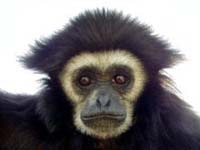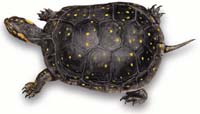

In May 2003, I completed my Ph.D.
with Dr. Karen Bjorndal
as my major research advisor. For my dissertation research, I studied whether
microorganisms (bacteria, protozoa, and nematodes) that reside in the bullfrog
tadpole gut contribute to their nutrition and digestion. Essentially, I studied
whether tadpoles are like miniature cows, in the sense that microbes within their guts help them digest their food!

In 2001, I conducted a nutritional
study on endangered Gulf of Mexico Sturgeon with Dr. Richard Miles, Dr. Frank
Chapman, and Juli-Anne Royes. We investigated whether a certain yeast extract
(mannanoligosaccharides), when added to the diet, can enhance growth and gut structure
in these fish. The yeast extract has been shown to improve growth and stimulate
the immune system in many domesticated animals, including pigs, dogs, and even
ostriches! Our study is the first to examine the effect (if any) of this dietary
supplement on the growth rates and gut structure of fish.

In December 1999, I completed my Master's
Degree in Zoology with Dr. Doug Levey as my major research advisor. In this study,
I determined the protein requirements and digestive strategies of three species
of parrots. I worked with parrots from the Bronx Zoo / Wildlife Conservation Society,
and Busch Gardens, Tampa Bay.

In 1996, while working for The Nature
Conservancy, I studied an endangered species of moth (the Bog Buck Moth) in Upstate
New York. I spent many hundreds of hours in the field studying the life history,
feeding habits, and general ecology of these unusual moths.

As an undergraduate student, I worked
on two projects with the Burnet Park Zoo in Syracuse, NY. I initiated a feeding
behavioral enrichment study with White-faced Gibbons, in which the gibbons were
provided with a hanging "puzzle box feeder" that I constructed. I was happy to
see the apes spend many hours investigating and feeding from the box, which presented
food in a more natural and intellectually-stimulating fashion (that is, while
the apes hung from branches and from the ceiling).

At the Burnet Park Zoo, I also studied Spotted Turtles as a
model for head-starting locally endangered Bog Turtles. In this study, I worked closely with Dr. Peter Rosenbaum, at Oswego State University (NY). We monitored Spotted
Turtles that had been given a "dietary boost" in captivity (hatched in the zoo
and fed a high-quality diet for about a year), then released into the wild. Hopefully,
based on this research, Bog Turtles will be sucessfully head-started and released
into the wild with the goal of increasing populations of this species in Western
New York state.

Written by Greg Pryor, 2004. This web site is for educational purposes; if you own an image on this
site and would like it removed or used with permission, or if you have comments,
corrections, or suggestions, please contact
me.


![]()





